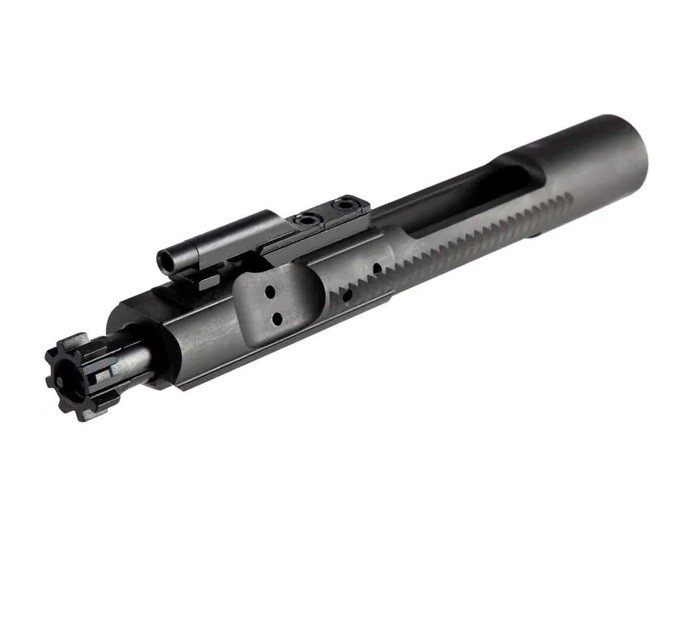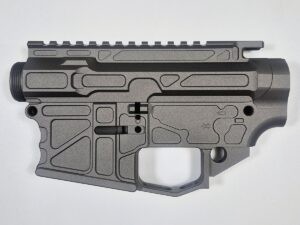The Bolt Carrier Group Or BCG Is The Heart Of The AR-15’s Operation
It ties the gas and recoil systems together with the trigger group. It also deals with firing and feeding ammunition. Because of this, the BCG is put under a lot of stress. This means picking the right BCG is important.
To help make this easier, we’re going to go over the different parts and factors that go into the different types of BCGs for your AR-15.
Bolt Carrier Basics
Bolt Carrier Groups all have the same basic combination of parts. Before we go into what these can be made of and coated with, we are going to go over these parts and the two different styles of bolt carriers.
Bolt Carrier Parts
The bolt carrier group is made of the bolt carrier, the gas key, the bolt, the extract/ejector, and various pins. These pins are the firing pin and the cam pin. These each serve a purpose in the function of the firearm and damaged or improperly sized parts can affect the performance of your rifle.
Carrier/Gas Key
The gas key or carrier key is on top of the BCG. Its function is to direct the gas from the direct impingement system into the carrier. This process wears down the key over time and it will eventually have to be replaced. To allow for it to be easily replaced, the gas key is a separate piece from the BCG and is secured by two screws.
Bolt
The bolt deals directly with the ammunition. It holds the firing pin, extractor, and ejector. This “star” shaped bolt head protrudes from the front of the BCG and moves back and forth in the carrier during the firing sequence, rotating to lock and unlock the BCG.
The bolt provides the necessary resistance needed to safely cycle the gun. Since it does lock in place, it holds the breach closed until the gas pressure reaches the appropriate levels to unlock the bolt and force it rearward.
Extractor and Ejector
While the bolt is going back and forth, the extractor and ejector are working on the ammunition in the gun. The extractor serves multiple purposes. When the bolt returns to battery, the extractor helps pick the next round up while lining the primer up with the firing pin. It then holds the cartridge in place until the gun is fired when it helps pull the spent case out of the chamber.
At this point the ejector pushes the case out of the grip of the extractor and the case is “tossed” out of the gun from the recoil of the BCG.
Gas Rings, Firing Pin, and Cam Pin
At the rear of the bolt, there is a small chamber. This chamber is sealed off with small rubber rings/seals called gas rings. This is where the gas key directs the gas. As the pressure builds, it forces the bolt backward.
Through the middle of all of this is the firing pin. This is hit by the hammer of the trigger group and activates the cartridge’s primer.
The cam pin holds most of this in place and allows for the rotation of the bolt in the BCG. All of the parts are held together with a cotter pin called the retainer or firing pin retainer.
AR-15 Bolt Carrier
This is one of the options for bolt carrier groups. The carrier interacts with the recoil spring and holds the rest of the BCG’s parts together. The standard AR-15 style carrier is designed to only work with a semi-automatic trigger group. Because of this there is less material near the rear of the carrier.
This means that there is a shelf farther back on the bottom of the carrier that does not correspond with the shelf on the top of the carrier.
M16 Style Bolt Carrier
An M16 style bolt carrier is mostly interchangeable with the AR-15 bolt carrier. However there is one major difference. The rear of the M16 style carrier features two equally long shelves on the top and bottom of the carrier. This allows the bolt carrier to be compatible with select fire/fully automatic trigger groups.
Using this style of bolt carrier is perfectly legal because it does not make the gun capable of automatic fire. This can only be achieved with other internal modifications and the appropriate trigger group. You should check your local and federal laws regarding ownership of a fully automatic rifle.
Using an M16 style carrier can reduce felt recoil and is overall a more durable option than a standard AR-15 style carrier.
Bolt Carrier Specifications
A BCG is only as good as the materials it is made out of and treated with. To ensure a safely operated gun, firearms manufacturers use specific materials, tests, and practices to help avoid parts breakages and similar occurrences.
Testing and Quality Control
There are multiple tests used to ensure that a BCG is within the normal specifications of the manufacturer’s tolerances. These include high-pressure testing and magnetic particle inspection. The other methods are quality control practices and include chrome lining, gas key staking, and the use of a shrouded firing pin.
High-Pressure Testing (MPT)
This test uses a high-pressure round to test the durability of the BCG. A round loaded at or near the highest levels of safe pressure for that round is fired using the BCG. If the BCG does not fail or experience a noticeable amount of damage, it passes the test.
This is the less scientific method of testing, but it does show the durability of the BCG.
Magnetic Particle Inspection (MPI)
This method is the more technical and repeatable test. The BCG will be covered in a magnetic dye and a current will then be applied to the BCG. The current will cause the dye to be attracted to any imperfections in the metal by the distortion of the magnetic field they produce. This makes any imperfections visible, such as cracks or other flaws.
Chrome Lining
The inner section of the BCG, specifically where the bolt sits, are usually chrome lined. It will not be shiny and reflective, but it will be silvery and matter in color. This creates a smooth surface for the bolt to slide back and forth on to reduce excessive heat, pressure, and friction during use.
Staked Gas Key
Since the gas key needs to be a replaceable part, the gas key is screwed down into place. These screws can work their way loose under recoil and need to be held in place. This is easily done by staking the screws. This is where a punch or similar tool is used to push some of the metal into the screw to prevent rotation. This usually looks like a set of dimples that overlap part of the screw edge. Improper staking can result in the gas key coming loose.
Shrouded Firing Pin
A shrouded firing pin helps preserve the firing pin’s life cycle. If the pin is unshrouded it runs the risk of impacting the hammer of the trigger group. This will wear both the hammer and pin down, causing them to degrade faster than normal. This can occur more if the hammer is notched. Using a shrouded firing pin saves parts and effort when using the gun.
Bolt Steels
While most steel options will work for your gun, some people need higher durability to stress and heat. A more durable BCG allows for longer use, but budget and availability will determine which option is best for you.
Bolt carriers are usually made out of combinations of steels for different parts, as each steel offers different benefits.
8620 Bolt Steel
This is the baseline for BCG steel. 8620 steel was the original military specification for the bolt carrier. It provides enough durability while remaining affordable and is still used by the US Military for their bolt carriers today, but this steel is not used in the bolt itself.
9310 Bolt Steel
This steel offers a higher tensile and yield strength than 8620. 9310 steel was developed after the initial version of the AR-15 and is another popular alloy to make BCGs out of. It brings higher durability and better resistance to heat and pressure. It is not uncommon to see both the bolt carrier and the bolt to be made of 9310 steel.
Carpenter No. 15
This steel has a higher tensile strength and yield compared to 9310, Carpenter No. 158 steel is the preferred steel for bolts for the US military. This is because of the increased resistance to high pressures, friction, and heat.
S7 Tool Steel
This option is a custom bolt option. BCGs made from S7 tool steel are able to take extreme amounts of pressure and strain, but come at a higher cost than other steels. This option is provided by the Sharps Rifle Company and is for those who want more durability no matter the cost.
Coatings
Coating steel allows for better resistance to rust and a smoother action. Coatings can fill in some imperfections in the steel while providing extra heat resistance.
Phosphate or Melonite/Nitride Coating
Phosphate or Nitride finishes are the most common option. This coating is used on the barrels, upper receivers, and lower receivers in addition to the BCG. It is affordable and provides resistance to corrosion and heat with minimal oiling or lubrication. Some Nitride finishes are referred to by the brand name Melonite and offer no additional benefits.
Nickel Boron (NiB) Coating
This coating is applied by putting the BCG in a liquid chemical bath and applying a Nickel Boron solution. This protects the metal and makes the BCG more “slick”. This reduces wear and allows the gun to run with little to no lubrication.
Nickel Boron treated BCGs are known to withstand friction and heat much better than phosphate coatings. Additional benefits are easier cleaning without the need for harsh chemicals or solvents. However these BCGs are more expensive.


